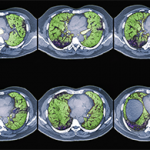“In our scleroderma clinic, we are very cautious with steroids and try to minimize their use to only when really necessary.” Other treatment options currently used for CTD-ILD include non-selective immunosuppressive therapies such as cyclophosphamide and mycophenolate mofetil. A recently published, randomized trial, the Scleroderma Lung Study-II, comparing mycophenolate and cyclophosphamide, shows possible effectiveness for both drugs.1 Findings suggest that mycophenolate is associated with fewer side effects and may have a safer profile, Dr. Boin said.
High-dose cyclophosphamide therapy with bone marrow rescue by hematopoietic stem cell transplantation has been shown to be feasible in scleroderma patients, with improvement of skin disease and stabilization of lung function. But high treatment-related mortality remains a relevant limitation to this approach. Novel treatments with anti-fibrotic properties, recently approved by the Food and Drug Administration for idiopathic pulmonary fibrosis, include pirfenidone and nintedadib.2,3 Future treatment options for scleroderma/CTD and ILD may include rituximab, tocilizumab and other biologic therapies, alone or in combination. Rituximab, a monoclonal antibody directed against B cells, is gaining popularity as several reports and case series have shown some benefit.
“Combination therapy using, at different stages of the disease, immunomodulators and anti-fibrotic drugs may be the most effective strategy, but it clearly awaits formal clinical studies to be further explored,” he said.
Pulmonary Hypertension Is Associated with Poor Prognosis
Dr. Fischer also discussed the diagnosis of pulmonary hypertension (PH), defined as elevated pulmonary blood pressure where the disease process causes thickening and constriction in the pulmonary artery. PH, which the World Health Organization has described in a clinical classification system of five patterns based on etiology,4 is characterized by increased pulmonary vascular resistance that causes the right-sided heart muscle to weaken and eventually fail.
One of these five types of PH is PAH, a condition of the pulmonary artery itself, with restricted flow and elevated rates of pulmonary artery pressure and pulmonary vascular resistance. In the REVEAL Registry, CTDs are associated with one-quarter of all PAH cases, while 10–15% of all systemic sclerosis patients develop PAH.5 PAH is also associated with other CTDs, including systemic lupus erythematosus, antiphospholipid syndrome and mixed connective tissue disease.
Effective screening should lead to earlier detection of PAH and earlier intervention with specific PAH therapies, Dr. Fischer said. Screening for PAH is very important, and it is indicated annually for all patients with systemic sclerosis and mixed connective tissue disease. There are different screening algorithms; none is perfect. But it is important to have a strategy for screening in place with a goal for earlier detection of disease, he emphasized. “You cannot confirm PAH without a right heart catheterization.” Consider a right heart catheterization if PAH is suspected, in order to confirm its presence, determine cardiac hemodynamics to help grade severity, guide therapy and exclude other etiologies for PH.

